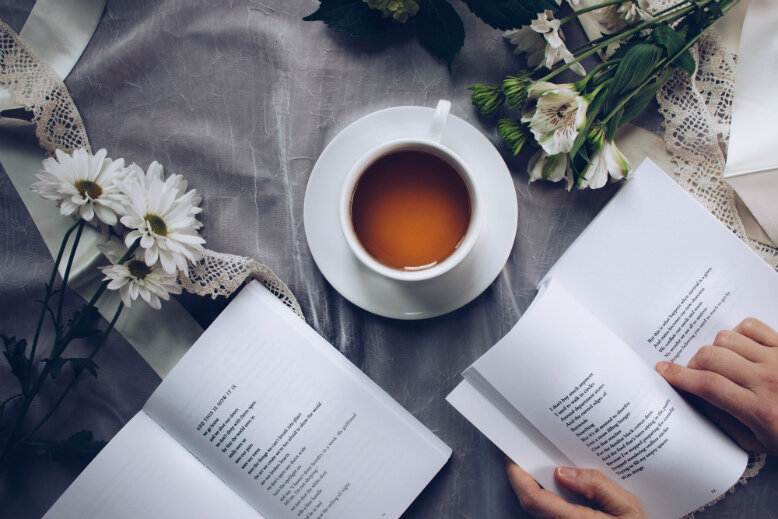Sandwiched in between countless OOTDs and breathtaking travel snaps is the Instagram poem. Its stark plainness catches your eye: familiar language cut up in brief lines, dressed in simple serif font type, and laid over a cream texture background as if freshly inked by a typewriter. If not on your feed, then there's a chance you'll encounter it contained within a five-second story atop. You usually see it shared, because a friend had recently gone through a heartbreak, and you *heart* it because maybe, you too could relate.
Many find themselves gravitating towards these kinds of works, proclaiming a newfound love for what they see as the modern-day version of the intimidating genre of poetry. “You don’t need to go to school or take a class to understand instapoetry, unlike the more classical poetry that we studied and tried to interpret while in school,” explains LA-based writer M.L. Cuesta, who turned to the genre after experiencing heartbreak. But more than the accessibility of the language, what really captures the heart of readers is the emotional relatability of instapoems. “It’s a new wave, and it’s the best wave to ride because it is the wave of human emotion,” she says. Her love for instapoetry inspired her to post her own poems on her Instagram account @cuestafilms, and recently, she self-published her anthology of poetry and prose entitled inbetween.
The same goes for Kristianne Ang. With the difficulties as an architecture student taking a toll on her well-being, she turned to instapoetry. “By reading, I realised it’s important to love and not be too hard on yourself,” she shares, specifically calling the hopeful words of Rupi Kaur as "encouraging."

From viral online verses, instapoems, later on, became best-selling books.
The popularity of instapoetry came as a surprise, as we became more and more at home with social media in the past decade. Rupi Kaur and Lang Leav are just two of the writers, dubbed as "instapoets", who draw most engagement internationally, prompting even celebrities to share some of their lines. In the region, we have writers Charissa Ong Ty, Timothy Joshua Chia, and Dawn Lanuza associated with the phenomenon. But their success didn't only remain within the virtual realm of social media. One by one, they scored book deals that have become mainstays in bookstores all over the world. Who knew that sharing short fragments on Instagram can land you a million-dollar book deal, right? But, really, what makes these words loved by many?
Uncomplicated words
Filipino poet Paolo Manalo, the Palanca award-winning author of Happily Ever Ek-ek, and Creative Writing professor at the University of the Philippines, Diliman touches on this subject in his free verse class. According to him, true to its name and like anything else made for online consumption, an instapoem should be read and understood in an instant. The language employed by instapoets is, more often than not, straightforward and conversational. Take American author R.H. Sin’s words from below as an example, “let him go / he does not / deserve to keep you.” You can take his words of advice at face value, no longer needing to read between the lines to analyse the meaning.
Some literary circles understandably use this easy language as a critique of the artistic value of instapoetry. But for immigrant writers like Rupi Kaur, whose work milk and honey outsold The Odyssey, the simple words required by the form is a good thing. According to The New York Times, the Indian-born author's desire to make her words accessible was influenced by her struggles with learning English when she first moved to Canada.
Down to form
Aside from the direct language, the bite-sized form also makes the poems suitable for social media, where short and sweet is the key to a boost in engagement. Paolo says, "You need verses or lines that will fit the frame of an Instagram post or story," and with that, it's easily digested. If it's too long or would require you more time to read between the lines, the casual viewer would easily scroll past. With this, they're more shareable, and therefore accessible, especially to non-traditional readers intimidated by poetry.
But instapoems don't always just end simply signed at the bottom with the author's pen name. He adds, "It's usually something that's short on a page and accompanied by something visual as contrast, either an object or an illustration."
Rupi Kaur more famously adopts this format, with her words framed by her elegant line illustrations at the side, which sometimes emphasise the message of her work. But overall, it adds a personalised charm to her work and helps her establish her distinct branding as an instapoet.
Lines and breaks
Words that mirror
But aside from how they're presented, the appeal of instapoems lie in the subject they present. Commonly, they come in the form of confessional aphorisms, that attempt to give advice to the reader. Others, meanwhile, attempt to describe for us feelings that we'd usually find hard to explain. Charissa Ong Ty’s “Meeting the One”, for one, tries to depict how it is when people meet their soulmates by detailing all the sensations we don’t feel with them. But instapoets don't really create a clear persona, allowing the readers to easily insert themselves in the situation. Through these words, we're brought back to remember the small things and small moments in life we often glorify in our memories.
A whole lot of them talk about love — emotions that are definitely universal, easily related to by the reader. In particular, "there tends to be more entries and pieces that are about unrequited, unfulfilled, or impossible love," according to Paolo. Perhaps, what makes them so popular is that, in a way, these written words serve as catharsis. Again, Instapoetry holds a mirror to ourselves, and with its straightforwardness puts into words feelings we would otherwise be unable to make sense of. For M.L., reading instapoems helped her understand how she felt, which ultimately helped her writing process. She notes, "Because instapoetry exists, I was able to find comfort in words and knew that somewhere out there, someone could relate to how I felt. It has saved me in so many ways."
Overall, Paolo comments, "there's a certain directness that works because of the given context created by the platform and the entries." Whether you agree with instapoetry's legitimacy as poetry or not, it's undeniable that the emerging form succeeds because of how it has been crafted to suit the medium it inhabits. Its easy consumption lends insight into the inner workings of the digital world ruled by the viral and trending. And ultimately, with the internet overwhelming its users with all these things to aspire to, these brief lines gives its readers a time to pause and indulge in our sensibilities.
In love with the written word? Check out these bookstores around Asia.
Comments, questions or feedback? Email us at [email protected].








